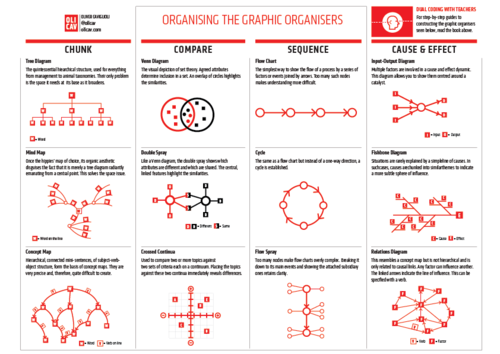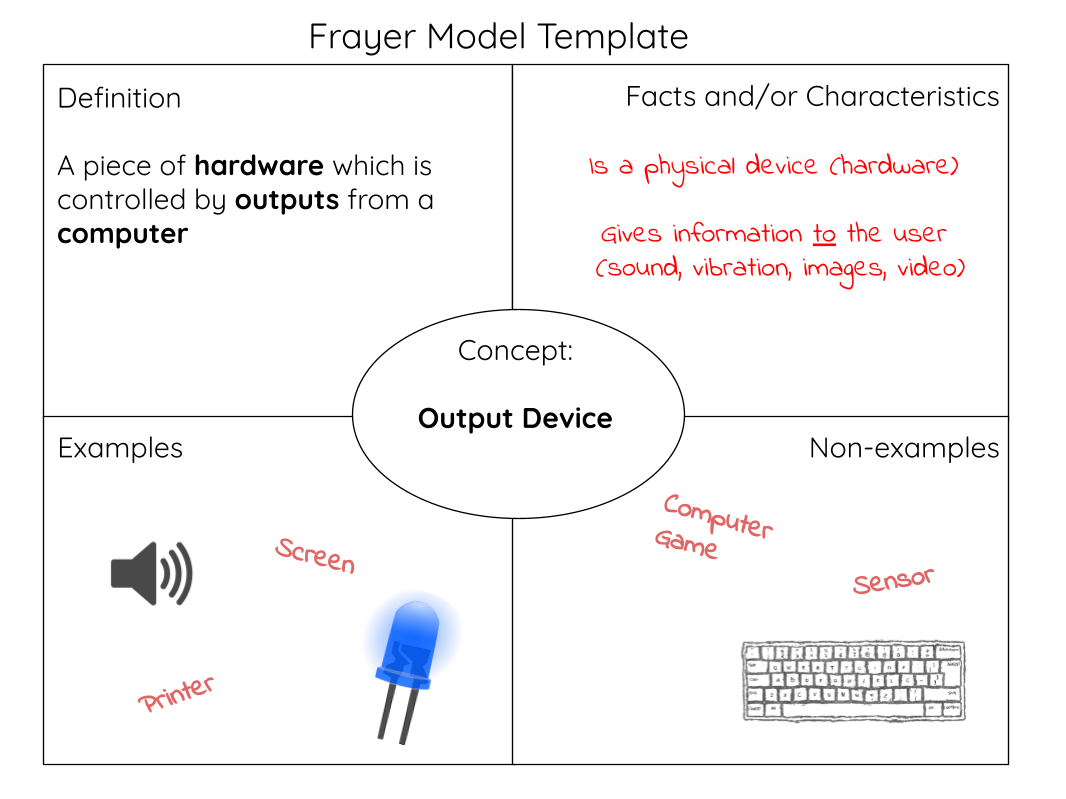Representing and organising knowledge
16 December 2021

As educators, it is important that we have a shared understanding of the knowledge and skills we’re teaching, and are able to prioritise the key concepts. With this shared knowledge, we are better equipped to support learners in acquiring, connecting, and retaining new ideas. There are a number of approaches that teachers can use to organise and represent knowledge which can:
- Ensure consistent understanding and focus between teachers
- Clarify focus, expectations, and key concepts for learners
- Provide reference material for learners, supporting retrieval practice
Knowledge organisers
Knowledge organisers come in a range of shapes and sizes, but each essentially summarises a topic down to a few pages. They typically include key terms, definitions, and other information (timelines, formulae, quotations, etc.) and originated as tools to provide clarity for educators as to the key knowledge within a unit of work. Since then, they have been used with learners (and other stakeholders, e.g. parents and school leadership), and even adopted as school-wide tools to support learning. Although how they are used varies, they are usually used as a reference at the beginning and end of units. Learners may be expected to learn and retrieve the knowledge outside of lessons through memorisation, quizzes, etc.
Despite their widespread use, there is little evidence that knowledge organisers directly support the acquisition of knowledge or its future retrieval. There are known benefits in learners retrieving previously acquired knowledge from their long-term memory. Likewise, there is evidence that regular retrieval practice such as self-quizzing supports learners in their retention and later recall of knowledge. However, the difference between this and knowledge organisers themselves is the surrounding instruction, practice, and pedagogy that drives learning — the tool itself is not enough.
Having an effective shared summary of key information, vocabulary, and definitions can be useful as a reference guide, but when we consider how the acquisition of knowledge occurs, there are a number of limitations:
- Knowledge organisers reduce an entire topic to a collection of key ideas. For the creator, selecting what is most relevant for the topic, the learners, and context is a challenging and time-intensive process that is easy to get wrong.
- Knowledge organisers provide limited instructional support that will aid novice learners in acquiring understanding of specific concepts.
- Long-term memory stores knowledge in collections of related concepts called schema. Typically, knowledge organisers consist of lists of facts, vocabulary, and definitions with limited organisation or relationships which are required to integrate them with our existing schemas.
- Knowledge organisers provide limited opportunities for learners to construct and organise their own knowledge, providing instead only a summary from an ‘expert’ which they don’t own.
Graphic organisers
Graphic organisers are a powerful tool that can be used to enhance knowledge organisers, or used independently as part of regular classroom practice. Whilst they come in many shapes and sizes, graphic organisers all use combinations of text, graphics, and positioning to illustrate relationships and organise information. On the surface, it may seem like these organisers are similar to knowledge organisers, however, their role in supporting the connections between core knowledge is what stands them apart.
Although they have gone by many names in the past, graphic organisers have shown themselves to be valuable and effective tools to aid learning in their acquisition and retention of knowledge. In Caviglioli’s chapter on this topic, he describes the different ways in which these tools can be categorised:
- According to Pehrsson and Denner, graphic organisers can be simply categorised by the type of knowledge they convey, things that stay the same (clusters of ideas) and things that change (where order is important). For example, a tree diagram shows hierarchical relationships between ideas whereas a flowchart represents a sequence of steps or ideas.
- Caviglioli proposes a further division of graphic organisers, splitting those representing static ideas into chunk and compare, and those representing change into sequence and cause and effect.
- Chunk – show relationships between words/concepts
- Compare – highlight similarities and differences
- Sequence – capture simple processes
- Cause and effect – illustrate causal relationships between events and actions
An important final distinction is that graphic organisers aren’t solely used for the presentation of knowledge but are often co-constructed. Learners that are unfamiliar with a topic may be given a preset template, created by the teacher with the understanding of how the knowledge relates, which students populate with content as they learn it. Where students are more comfortable with the content or technique a more free-form approach can be used where both the organisation and the content are directed by the student.
You can find more information and examples of graphic organisers at olicav.com where you’ll also find this poster, which categorises some examples of graphic organisers.

In previous blogs we’ve highlighted some particular examples of graphic organisers, including concept maps and their value in organising, communicating, and assessing knowledge, and learning graphs which the Teach Computing Curriculum uses to describe learning progression.
In practice, it’s important to remember that like any tool, the efficacy of graphic or knowledge organisers depends on how they are applied — the practice and pedagogy that surrounds them.
For example, whilst teaching learners about computer systems, I might prepare a knowledge organiser alongside colleagues outlining the key vocabulary and concepts students should understand, as well as highlighting other contextually relevant information. I would probably share this with students to help gauge their prior knowledge, and use it as a point of reference throughout the unit.
Throughout my teaching of the unit, I’d choose appropriate tools to expand on these key concepts following a semantic wave approach to develop meaning. Additionally, I’d use graphic organisers to highlight relationships and provide structure to the knowledge.
I’m certainly going to make use of a flowchart graphic organiser to illustrate the input process output (IPO) model. I would also likely choose to use a Frayer model (part of the chunk category of graphic organisers) to expand the concepts of input and output devices and their related definitions.
During our discussions around input and output devices we’d collaboratively build on our definition, adding characteristics, examples, and non-examples to the model. We’d record this in the students’ books or somewhere they could refer back to, perhaps even on a knowledge organiser if space allowed.

Choosing the right tool for the job
Here we’ve highlighted a selection of tools for organising knowledge and supporting learners in its acquisition and retention. Our top tips for educators to takeaway:
- When selecting a tool to help structure and organise knowledge, reflect on your purpose, audience, and the type of subject matter involved. Different tools will be more/less appropriate in each situation.
- Consider what experience/support learners need with how to use the tool effectively. To what extent will your learners complete or organise their own knowledge? Are they confident enough to select an appropriate organisation approach themselves?
- Consider your own practice and when and how you're going to use the organiser you create as part of your teaching and learning repertoire.